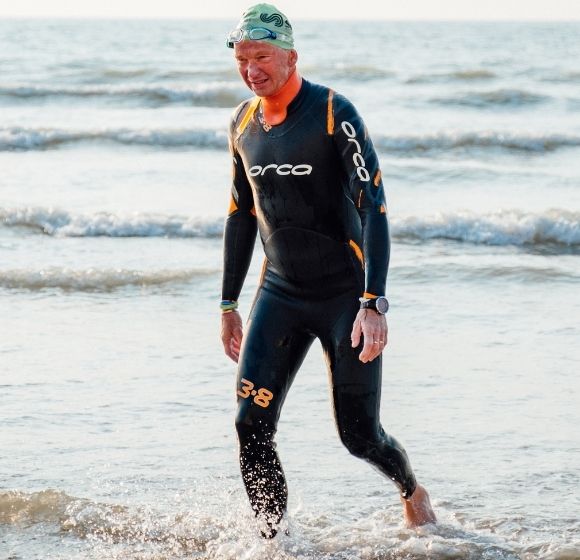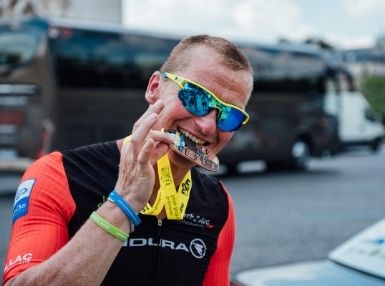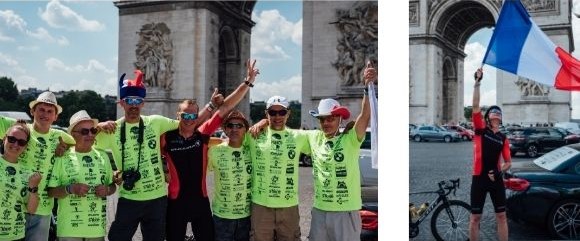
LUDOVIC CHORGNON
Endura’s Enduroman
ENDUROMAN #29
De l’Arch à l’Arc. De Londres à Paris. Courir de Londres à Douvres. Nager entre Douvres et Calais. Rouler de Calais à Paris. 140 km. 34 km. 291 km. Peu importe l’ordre des épreuves, l’Enduroman est une course extrême, un triathlon sans commune mesure. C’est aussi une course aux variables incontrôlables. Les capitales sont des villes où il est difficile de circuler, sont encombrées de trafic et en proie à la pollution. Les traversées de la Manche à la nage sont rarement simples et, avec une nage dépendante des marées, ne sont jamais en ligne droite. Cela signifie-t-il que la partie vélo est la plus facile ? C’est possible, sauf que vous êtes partis depuis plus 40 heures au moment où vous montez sur le vélo.Cette épreuve est si difficile que seulement une poignée d’ultra-athlètes ont terminé le défi depuis sa création en 2001. Beaucoup ont échoué et un concurrent malheureux, Douglas Waymark, est décédé lors de sa tentative.
Le français Ludovic Chorgnon avait pour but d’être #29. Un vétéran aux multiples courses ultra et extrêmes. Ses résultats sont tout simplement remarquables – une liste interminable de courses brutales. L’Ultramarathon de Badwater – surnommé la course à pied plus difficile. Le Marathon des Sables – une course de six jours au travers le désert du Sahara. L’Himal Race - 900 km entre le Tibet et le Népal. La liste est longue...
Ludovic est probablement plus connu pour avoir enchaîné une série des triathlons sur distance Ironman en 2005, ce qui lui a valu une place dans le Guinness World Records. Entre le 1er juillet et le 10 août 2015, Ludovic a complété 41 (quarante et un) triathlons longue distance – c’est 3,8 km de natation, 180,2 km de vélo et un marathon pour finir- tous les jours. Au total, le Défi41 l’a vu cumuler 155,8 km de natation, 7380 km de vélo et 1730 km de course à pied.
Compte tenu de leur expertise dans les vêtements cycliste aérodynamique et de la supériorité de leur combinaison tri ayant battu le record du monde, Endura était le partenaire tout indiqué et a été ravi de soutenir Ludovic sur sa tentative d’Enduroman. Ils l’ont suivi par le biais de son tracker, alors qu’il prenait le départ sous la Marble Arch à Londres jeudi dernier et l’ont regardé finir avec émerveillement chaque partie de la course:
De Londres à Douvres – 16 h 25 min / T1 6 h 24 min
De Douvres à Calais – 18 h 56 min / T2 4 h 55 min
De Calais à Paris – 13 h 59 min
Temps Total – 60 h 39 min
Ludovic n’est pas seulement devenu le 29ème Enduroman, il a terminé avec le deuxième temps le plus rapide de l’histoire. Bravo Ludovic!




How do you train for an event as extreme as the Arch to Arc?
Contrary to what everyone thinks, training is not what matters the most in this kind of race, of course it's essential, but I actually don't allow myself any SPOF, Single Point Of Failure. You can be in great shape but if you have a weakness in terms of diet or your joints, if you have a weakness at any level, you can lose everything. I work on the transversality of the workout, I did a lot of weight training, I worked on my posture to save energy while running, I worked on my posture with a professional dancer to improve my flexibility, I worked on my diet to avoid a deficit during the race. I see my physiotherapist every week, and he knows if I feel pain or tension at any time. I’ve worked more on my swimming technique than on the volume of swimming, how to make effective movements rather than trying to do more and more.
One wonders how a body accept repeated efforts for this long, more than 13-14 hours or even more than 18 hours for the swimming leg... Your body can do it just like mine can. When you learned to walk, you walked 2 metres between two pieces of furniture ten times and it became easy, then you walked across the room ten times, twenty times. I have been running for so long, that I run 40K every other day, you know. Running 40, 50, 100K has now become so common that it cannot have an impact.
“When you learned to walk, you walked 2 metres between two pieces of furniture ten times and it became easy, then you walked across the room ten times, twenty times.”
Obviously you don't go from a marathon to a challenge like this from one day to the next. I've capitalized on my experience, I do have a few 200, 400, 500, 900K races behind me, it helps a little. For the running leg, I’ve worked a lot on my posture and my stride to make it the most efficient, using my kinetic energy in the movement, keeping the same pace as much as possible and at the same time avoiding any unnecessary or consuming effort.
I did everything without a timer, just by feelings, never knowing where I was, and I told them the time I was going to do. It happened exactly as I planned. Swimming has been the hardest leg, I am an extremely picky person, I have a strong attention to detail, and that’s what I need to be in control. When I’m running, my subconscious tells me that everything is fine and I know it, I have benchmarks. At sea, you have no information, and I ended up asking where we were, I couldn't see anything, it was foggy and I couldn’t see the French coast. And finally, the pilot told me 'congratulations, you've got 1.5 km to go' and then I focused on my swimming, I swam faster, I knew it was almost over, and eventually I was 3km from the end instead of the 1.5km. An hour later, I was told "come on, only 2km to go" and I looked at them surprised...
"This is very tough mentally, being able to continuously tell yourself “I don't know where I am” and to keep going, accepting the unknown, willing to step back, accepting that the elements do what they want with me."
I was mad, I had gone backward. This is very tough mentally, being able to continuously tell yourself “I don't know where I am” and to keep going, accepting the unknown, willing to step back, accepting that the elements do what they want with me. You can't make a greater effort for more than half an hour or an hour if you don't know what will happen to you Whereas when I'm in high altitude, for example, I know very well what will happen at 5000-6000m, I have my altimeter that gives me information allowing me to adjust myself; at sea you have nothing. The Channel is harder psychologically than physically.

What was your biggest fear as you stepped up to the start line in London last week?
None, I knew I was going to make it. I told my team on the boat, from the moment I put a foot in the water, I would not understand and would not be able to speak English, meaning that I wouldn't understand if ever the officials told me to stop. I told them that whatever happened I would not go back to the boat before the end. I had no fear, I was eager and happy to relive this adventure with my team and to settle scores with the Channel.
You have completed a huge number of ultra-marathon events, how does Arch to Arc compare?
The Arch to Arc isn't my biggest achievement, even though crossing the channel has been difficult because I could not have all the information to control and manage my efforts. The more we are at a high level, the more we are in control and self-knowledge to manage an effort but the Channel does not allow it.
What is the best piece of advice that you've received that's helped your athletic career?
Technical advice, but not about the management. I've rather built my experience on my own. But for technical advice, there is one I provide and recommend to others, is to be effective, it’s essential. And often, for those who have a temperament like mine, we rather want to force through. And last year for my first participation to the Arch to Arc, I was ready to put three times more arm movements than necessary to swim, which doesn't help. You have to play with the elements. Clean technique is an oxymoron to maximum power. The typical caricature of us, is often to think we're Rambos, we'll fire up, but it is quite the opposite, you must think, manage, be gentle in the effort, whether in running, swimming and cycling.
What is your next challenge/target?
I did more than 70 Ironman in my life, but without ever trying my best, it was always training for other races. So I figure that for once in 2019 I might do one thoroughly to get a good time, go to the World Championship Ironman, or maybe run the Deca-Ironman Championships and run ultras. For 2019 I'll give myself almost mundane goals (laughs..) and better prepare myself for 2020. 2020 will be huge... and there will be cycling, so we can probably do things together with Endura, and I may have some product development ideas... I think I can tell you by the end of the year.
"For 2019 I'll give myself almost mundane goals..."
Thanks again to Endura for the outfits, it was just huge, everything fits perfectly. The kit is really well integrated, super comfortable, and top quality. During the bike part, I suffered significant temperature variations. Through the Picardy region at night, it was cold, foggy, with terrible humidity, and with the Pro SL thermal jacket I was comfortable. As soon as the sun rose, I put on the custom combination suit, which is really great. I tested Endura clothing before Arch to Arc, and I was more than confident for the race because the products are great.
Thank you for believing in me.
FOOTNOTES Interview: Simon Dawson, Translations: Tony Roybier. Images by Sean Hardy. Paris, France© 2021 ENDURA